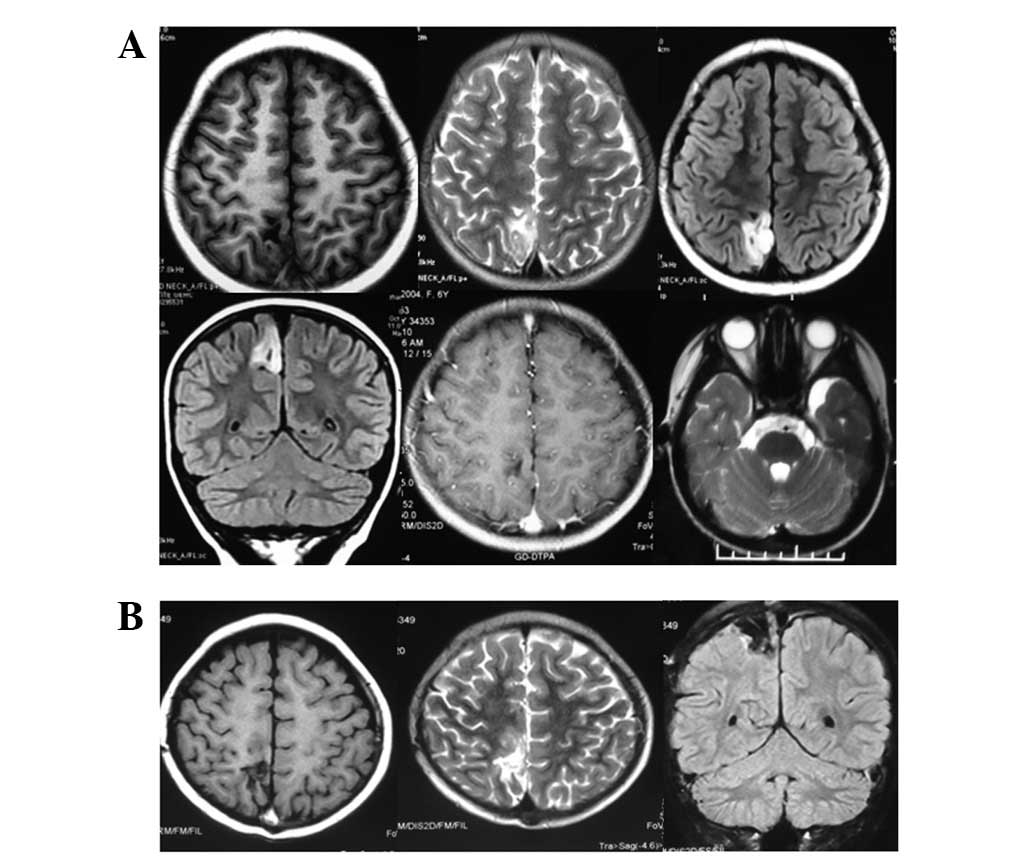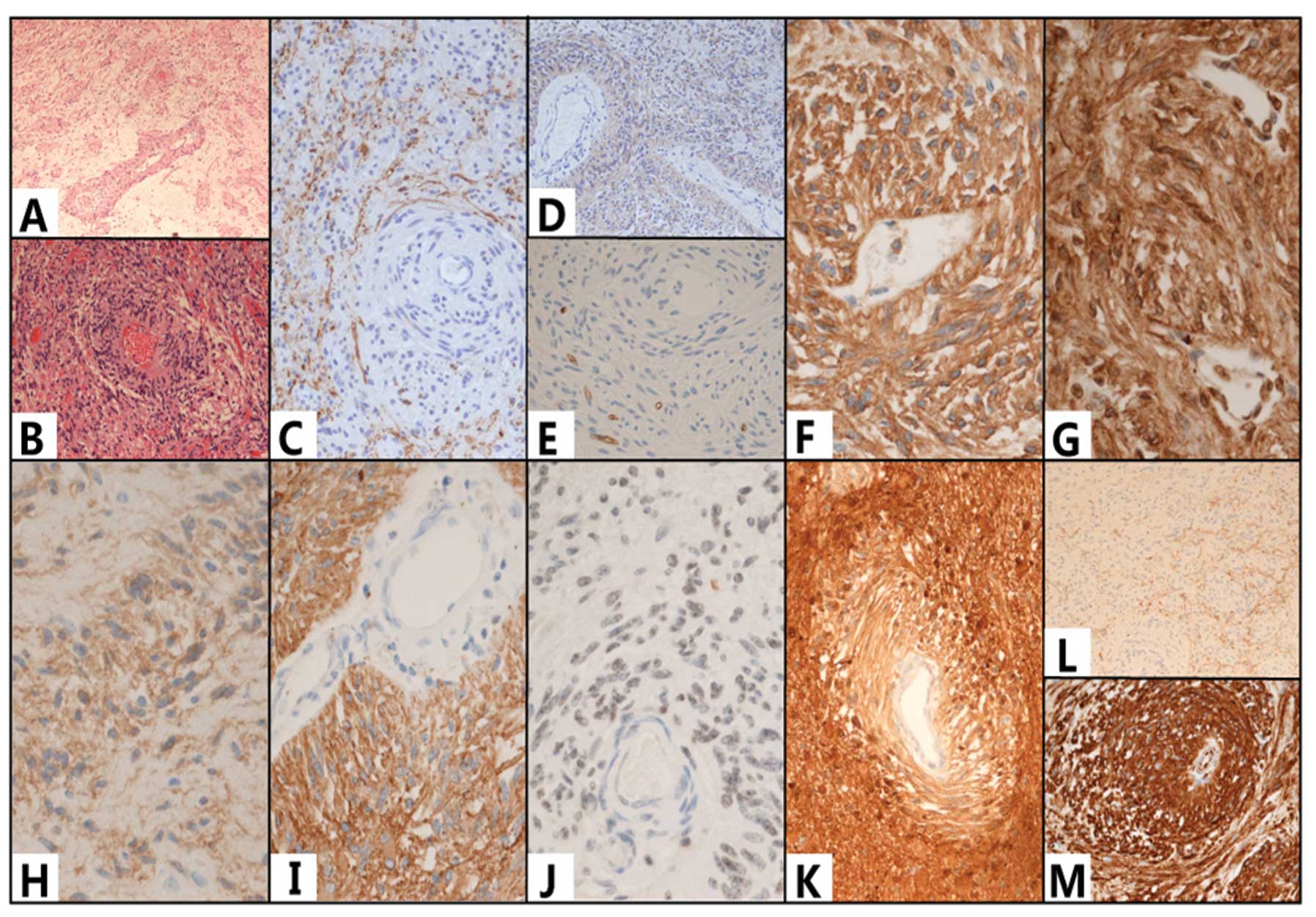|
1
|
Louis DN, Ohgaki H, Wiestler OD, et al:
The 2007 WHO classification of tumours of the central nervous
system. Acta Neuropathol. 114:97–109. 2007. View Article : Google Scholar : PubMed/NCBI
|
|
2
|
Fulton SP, Clarke DF, Wheless JW, et al:
Angiocentric glioma-induced seizures in a 2-year-old child. J Child
Neurol. 24:852–856. 2009.PubMed/NCBI
|
|
3
|
Rho GJ, Kim H, Kim HI and Ju MJ: A case of
angiocentric glioma with unusual clinical and radiological
features. J Korean Neurosurg Soc. 49:367–369. 2011. View Article : Google Scholar : PubMed/NCBI
|
|
4
|
Amemiya S, Shibahara J, Aoki S, et al:
Recently established entities of central nervous system tumors:
review of radiological findings. J Comput Assist Tomogr.
32:279–285. 2008. View Article : Google Scholar : PubMed/NCBI
|
|
5
|
Lellouch-Tubiana A, Boddaert N, Bourgeois
M, et al: Angiocentric neuroepithelial tumor (ANET): a new
epilepsy-related clinicopathological entity with distinctive MRI.
Brain Pathol. 15:281–286. 2005. View Article : Google Scholar : PubMed/NCBI
|
|
6
|
Preusser M, Hoischen A, Novak K, et al:
Angiocentric glioma: report of clinico-pathologic and genetic
findings in 8 cases. Am J Surg Pathol. 31:1709–1718. 2007.
View Article : Google Scholar : PubMed/NCBI
|
|
7
|
Wang M, Tihan T, Rojiani AM, et al:
Monomorphous angiocentric glioma: a distinctive epileptogenic
neoplasm with features of infiltrating astrocytoma and ependymoma.
J Neuropathol Exp Neurol. 64:875–881. 2005. View Article : Google Scholar : PubMed/NCBI
|
|
8
|
Arsene D, Ardeleanu C, Ogrezeanu I and
Danaila L: Angiocentric glioma: presentation of two cases with
dissimilar histology. Clin Neuropathol. 27:391–395. 2008.
View Article : Google Scholar : PubMed/NCBI
|
|
9
|
Lum DJ, Halliday W, Watson M, et al:
Cortical ependymoma or monomorphous angiocentric glioma?
Neuropathology. 28:81–86. 2008. View Article : Google Scholar : PubMed/NCBI
|
|
10
|
Sugita Y, Ono T, Ohshima K, et al: Brain
surface spindle cell glioma in a patient with medically intractable
partial epilepsy: a variant of monomorphous angiocentric glioma?
Neuropathology. 28:516–520. 2008. View Article : Google Scholar : PubMed/NCBI
|
|
11
|
Covington DB, Rosenblum MK, Brathwaite CD
and Sandberg DI: Angiocentric glioma-like tumor of the midbrain.
Pediatr Neurosurg. 45:429–33. 2009. View Article : Google Scholar : PubMed/NCBI
|
|
12
|
Sun FH, Piao YS, Wang W, et al: Brain
tumors in patients with intractable epilepsy: a clinicopathologic
study of 35 cases. Zhonghua Bing Li Xue Za Zhi. 38:153–157.
2009.(In Chinese).
|
|
13
|
Hu XW, Zhang YH, Wang JJ, et al:
Angiocentric glioma with rich blood supply. J Clin Neurosci.
17:917–918. 2010. View Article : Google Scholar : PubMed/NCBI
|
|
14
|
Ma X, Ge J, Wang L, et al: A 25-year-old
woman with a mass in the hippocampus. Brain Pathol. 20:503–506.
2010.PubMed/NCBI
|
|
15
|
Mott RT, Ellis TL and Geisinger KR:
Angiocentric glioma: a case report and review of the literature.
Diagn Cytopathol. 38:452–456. 2010.
|
|
16
|
Rosenzweig I, Bodi I, Selway RP, et al:
Paroxysmal ictal phonemes in a patient with angiocentric glioma. J
Neuropsychiatry Clin Neurosci. 22:118–123. 2010. View Article : Google Scholar : PubMed/NCBI
|
|
17
|
Marburger T and Prayson R: Angiocentric
glioma: a clinicopathologic review of 5 tumors with identification
of associated cortical dysplasia. Arch Pathol Lab Med.
135:1037–1041. 2011. View Article : Google Scholar : PubMed/NCBI
|
|
18
|
Pokharel S, Parker JR Jr, Parker J, et al:
Angiocentric glioma with high proliferative index: case report and
review of the literature. Ann Clin Lab Sci. 41:257–261.
2011.PubMed/NCBI
|
|
19
|
Takada S, Iwasaki M, Suzuki H, et al:
Angiocentric glioma and surrounding cortical dysplasia manifesting
as intractable frontal lobe epilepsy - case report. Neurol Med Chir
(Tokyo). 51:522–526. 2011. View Article : Google Scholar : PubMed/NCBI
|
|
20
|
Li JY, Langford LA, Adesina A, et al: The
high mitotic count detected by phospho-histone H3 immunostain does
not alter the benign behavior of angiocentric glioma. Brain Tumor
Pathol. 29:68–72. 2012. View Article : Google Scholar
|
|
21
|
Prayson RA: Tumours arising in the setting
of paediatric chronic epilepsy. Pathology. 42:426–431. 2010.
View Article : Google Scholar : PubMed/NCBI
|
|
22
|
Prayson RA, Fong J and Najm I: Coexistent
pathology in chronic epilepsy patients with neoplasms. Mod Pathol.
23:1097–1103. 2010. View Article : Google Scholar : PubMed/NCBI
|
|
23
|
Lehman NL: Central nervous system tumors
with ependymal features: a broadened spectrum of primarily
ependymal differentiation? J Neuropathol Exp Neurol. 67:177–188.
2008. View Article : Google Scholar : PubMed/NCBI
|












